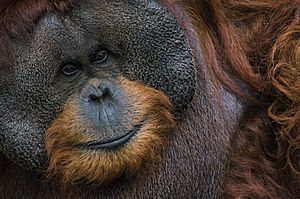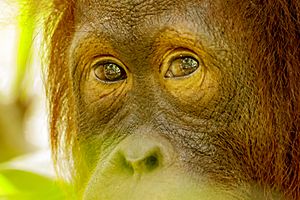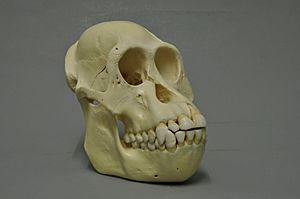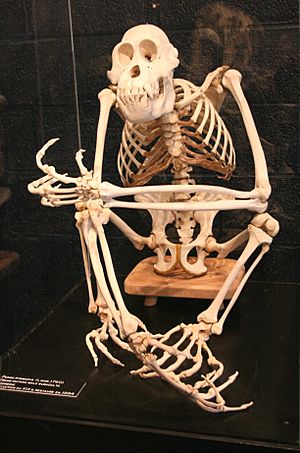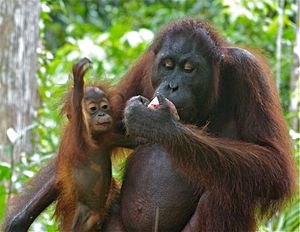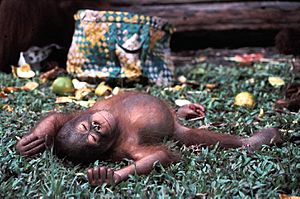Bornean orangutan facts for kids
Quick facts for kids Bornean orangutan |
|
|---|---|
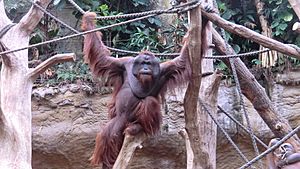 |
|
| Male | |
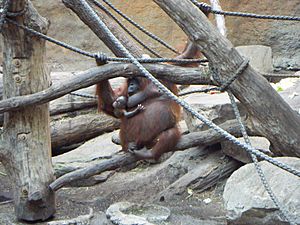 |
|
| Female with infant Both at Allwetterzoo Münster |
|
| Conservation status | |
| Scientific classification | |
| Subspecies | |
|
|
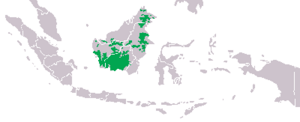 |
|
| Distribution of Pongo pygmaeus in Borneo | |
| Synonyms | |
|
P. agris (Schreber, 1799) |
The Bornean orangutan (Pongo pygmaeus) is a type of orangutan that lives on the island of Borneo. It is one of only three kinds of great apes found in Asia. The other two are the Sumatran orangutan and the Tapanuli orangutan. Like other great apes, orangutans are very smart. They use tools and have special ways of living that are passed down through their groups. Orangutans share about 97% of their DNA with humans.
Sadly, the Bornean orangutan is an endangered species. This means it is at a very high risk of disappearing forever. The main reasons for this are deforestation (forests being cut down), the growth of palm oil farms, and hunting.
Contents
About the Bornean Orangutan
The Bornean orangutan and the Sumatran orangutan became different species about 400,000 years ago. For a long time, scientists thought they were just different types of the same orangutan. But in 1996, after studying their DNA, scientists decided they were two separate species.
There are three main groups, or subspecies, of the Bornean orangutan:
- Northwest Bornean orangutan (P. p. pygmaeus) – found in Sarawak (part of Malaysia) and northern West Kalimantan (part of Indonesia).
- Central Bornean orangutan (P. p. wurmbii) – found in southern West Kalimantan and Central Kalimantan (Indonesia).
- Northeast Bornean orangutan (P. p. morio) – found in East Kalimantan (Indonesia) and Sabah (Malaysia).
In 2014, about 50 orangutans were found in South Kalimantan Province. This was a surprise because orangutans had not been recorded there before.
Bornean orangutans are part of the Hominidae family, which also includes humans. This means they are some of our closest living relatives.
The name Pongo comes from an African word for a large ape. The word pygmaeus comes from a Greek word meaning "dwarf."
Physical Features
The Bornean orangutan is the second largest ape, after the gorilla. It is also the largest animal that truly lives in trees. While humans can be taller, orangutans can be very heavy. Sumatran orangutans are similar in size but usually a bit lighter.
In the wild, male orangutans weigh about 75 kilograms (165 pounds) and are 1.2 to 1.7 meters (4 to 5.5 feet) tall. Females are smaller, weighing about 38.5 kilograms (85 pounds) and are 1 to 1.2 meters (3 to 4 feet) tall. Orangutans in zoos can become much heavier, sometimes over 165 kilograms (364 pounds).
Bornean orangutans have very long arms, which can reach up to 1.5 meters (5 feet) long. They have gray skin and shaggy, reddish fur. Their hands and feet can grasp things, which helps them move through trees. Unlike most mammals, their faces are not covered in fur, but they do have a beard and mustache.
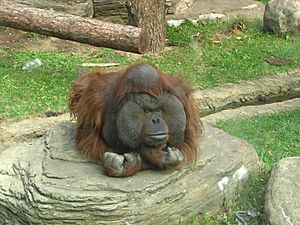
Males and females look quite different. Males have much larger, fatty cheek pads called flanges. Females have smaller flanges. Males also have bigger canine teeth and a more noticeable beard and mustache. The throat sac, which males use to make loud calls, is also much larger in males. There are two types of adult males: smaller ones and larger, more dominant ones. Both types can successfully have babies. When they are born, male and female orangutans look very similar.
Where They Live
The Bornean orangutan lives in tropical and subtropical moist broadleaf forests in the lowlands of Borneo. They can also be found in mountains up to 1,500 meters (4,900 feet) high. These orangutans spend their lives in the tops of tall trees in both old and new forests. They travel long distances to find trees that have fruit.
They are found in two Malaysian states, Sabah and Sarawak, and in four of the five Indonesian provinces of Kalimantan. Because their homes are being destroyed, orangutans are now found in scattered groups across the island. They are rare in the southeast and in some forests between the Rajang River and the Padas River.
Long ago, orangutans lived across Southeast Asia, including parts of China, Java, and Sumatra. Fossils show that they were once found on the mainland, even though today they only live on Borneo and Sumatra.
Behavior and Daily Life
Bornean orangutans are more solitary than their Sumatran relatives. This means they prefer to be alone. Sometimes, two or three orangutans whose territories overlap might meet, but only for a short time. Adult males will act threateningly if they meet other males. They only spend time with females to mate. Males are the most solitary of all orangutans.
In the wild, Bornean orangutans usually live for 35 to 45 years. In zoos, they can live to be about 60 years old.
Even though they live in trees, Bornean orangutans walk on the ground more than Sumatran orangutans. This might be because there are no large predators like tigers in Borneo that would threaten them on the ground. Sumatran orangutans have to watch out for the fierce Sumatran tiger.
Bornean orangutans build nests. They make these nests to sleep in at night or to rest in during the day. Young orangutans learn how to build nests by watching their mothers. They practice this skill as they grow up. Nests can be very detailed, with a base and a soft "mattress" made by weaving leaves and branches together. They might even add a roof for shade or rain, a "pillow," and a "blanket" made from branches and leaves. Building nests is seen as a type of tool use for primates.
Diet
Bornean orangutans eat more than 400 different kinds of food. Their diet includes wild figs, durian fruit, leaves, seeds, bird eggs, flowers, honey, and insects. They also eat the inner parts of plants and vines. They get the water they need from fruit and from holes in trees.
Orangutans have been seen using tools in clever ways. They use leaves to clean themselves, or as a pad to hold spiky durian fruit. They might use a leafy branch to swat away bees, or hold a bunch of branches together like an "umbrella" when it rains. They can even use a stick to scratch their backs or throw a branch as a missile. In some areas, orangutans eat soil. This helps them get minerals and can help with toxins from their plant-based diet. Sometimes, very rarely, orangutans will eat smaller animals like slow lorises.
Reproduction and Life Cycle
Male and female orangutans usually only meet to mate. Younger males might try to mate with any female. Dominant adult males make loud calls to attract females. Females often prefer to mate with these larger, flanged males. Adult males often try to mate with females who have recently weaned their babies, because these females are likely to be ready to have another baby.
Female orangutans are ready to have babies when they are about six to 11 years old. They usually give birth for the first time around 14 or 15 years old. Newborn orangutans drink milk from their mothers every few hours. By four months old, they start to eat soft food from their mother's lips. For their first year, young orangutans cling tightly to their mother's belly.
Babies are usually weaned (stop drinking milk) around four years old, but it can be much longer. After weaning, they start to explore more, but they always stay close to their mother. During this time, they also look for other young orangutans to play with. On average, young orangutans do not become fully independent until they are about seven years old. The number of babies orangutans are having has been going down. This is mainly because they don't have enough food due to their habitat being lost.
Conservation Efforts
The Bornean orangutan is more common than the Sumatran orangutan, with about 54,500 individuals left in the wild. However, the Sumatran orangutan has only about 15,000 left. Orangutans are becoming more and more endangered because their homes are being destroyed and because of illegal hunting. Young orangutans are often captured to be sold as pets, which usually means their mothers are killed.
The Bornean orangutan is listed as critically endangered by the IUCN Red List. This means it faces a very high risk of becoming extinct in the wild. The total number of Bornean orangutans today is thought to be less than 14% of what it was in the past. This big drop has happened mostly in the last few decades because of human activities.
Their homes are being destroyed by illegal logging, forest fires, and the expansion of palm oil plantations. When forests are burned to make way for palm oil farms, orangutans lose their homes, and many are burned or killed in the fires. Palm oil is used in many everyday products like packaged foods, soaps, and shampoos.
Climate change also threatens Bornean orangutans. Changes in rainfall patterns in Indonesia mean there is less food available for them. This makes it harder for orangutans to get enough nutrients to stay healthy and have babies.
Even though Indonesian law protects orangutans, people who harm them are rarely punished.
Rescue and Rehabilitation Centers
Many groups are working to rescue and help Bornean orangutans. These centers help orangutans that have been hurt or orphaned. They teach them skills they need to survive in the wild.
- The Borneo Orangutan Survival Foundation (BOS) has rescue and rehabilitation centers in East and Central Kalimantan. They also work to protect and regrow the rainforests where orangutans live.
- Orangutan Foundation International rescues orangutans and prepares them to go back into protected areas of the Indonesian rainforest. They also work to save the rainforest itself.
- The Sepilok Orang Utan Rehabilitation Centre in Sabah, Malaysia, was the first official orangutan rehabilitation project, opening in 1964.
- Orangutan Foundation works in Central Kalimantan. They rescue orphaned orangutans and help them learn how to live in the wild. They also protect orangutan habitats and work with local communities.
Studies have shown that orangutans in zoos who are happier tend to live longer. This helps scientists understand how to better care for orangutans in captivity.
| NCBI genome ID | 10714 |
|---|
Scientists are working to map the entire genetic code (genome) of the Bornean orangutan.
Images for kids
See also
 In Spanish: Orangután de Borneo para niños
In Spanish: Orangután de Borneo para niños



